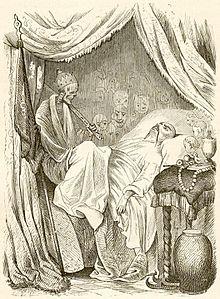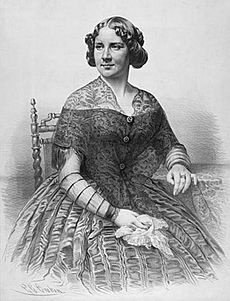The Nightingale (fairy tale) facts for kids
Quick facts for kids "The Nightingale" |
|
|---|---|

Illustration by Vilhelm Pedersen
|
|
| Author | Hans Christian Andersen |
| Original title | "Nattergalen" |
| Country | Denmark |
| Language | Danish |
| Genre(s) | Literary fairy tale |
| Published in | New Fairy Tales. First Volume. First Collection (Nye Eventyr. Første Bind. Første Samling) |
| Publication type | Fairy tale collection |
| Publisher | C.A. Reitzel |
| Publication date | 1843 |
"The Nightingale" is a famous fairy tale written by the Danish author Hans Christian Andersen. It tells the story of an emperor who loves the beautiful song of a real nightingale. But then, he gets a fancy, jewel-covered mechanical bird that sings too. He likes the mechanical bird more than the real one.
When the Emperor becomes very sick, the real nightingale comes back. Its amazing song helps him get better. This story was first published in Copenhagen in 1843. Many people believe Andersen was inspired to write it by his feelings for a famous opera singer named Jenny Lind. She was known as the "Swedish nightingale." The story has been made into operas, ballets, plays, TV shows, and even animated movies.
Contents
The Story of the Nightingale
The Emperor of China hears that the most beautiful thing in his whole empire is the song of a nightingale. He orders the bird to be brought to him. A kitchen maid, who is the only one at court who knows where the nightingale lives, takes everyone to a nearby forest.
The nightingale agrees to come to the palace. Its song becomes the Emperor's favorite. One day, the Emperor receives a gift: a mechanical bird covered in jewels. This bird can sing, but it's not real. The Emperor becomes so interested in the fake bird that he forgets about the real nightingale. The real nightingale then flies back to its forest home.
After some time, the mechanical bird breaks down. A few years later, the Emperor becomes very ill and is close to dying. The real nightingale hears about his condition. It flies back to the palace and sings its beautiful song. The song is so moving that it even makes Death leave the Emperor's side. The Emperor gets better, thanks to the nightingale's music.
How the Story Was Made
Hans Christian Andersen wrote "The Nightingale" very quickly, on October 11 and 12, 1843. He started writing it while visiting Tivoli Gardens in Copenhagen. Tivoli Gardens is a famous amusement park that had just opened and featured Chinese-style designs.
The story was first published on December 11, 1843. It was part of a collection called New Fairy Tales. First Volume. First Collection. This book also included other famous tales like "The Angel" and "The Ugly Duckling". "The Nightingale" was very popular and helped Andersen become even more famous.
Jenny Lind: The Swedish Nightingale
Andersen met a Swedish opera singer named Jenny Lind in 1840. He had strong feelings for her, but she only wanted to be friends. She even wrote to him in 1844, calling him her "brother." Jenny Lind was a very talented singer who became famous around the world.
Many people believe that Andersen wrote "The Nightingale" as a special tribute to her. He once wrote that Jenny Lind taught him how important art was. She showed him that artists should forget about themselves and focus on their art. He felt she had a very positive influence on him as a writer.
The story of "The Nightingale" helped make Jenny Lind known as "The Swedish Nightingale." This happened even before she became a huge star in Europe and the United States. Later in her life, Jenny Lind cared deeply for the composer Frédéric Chopin. His letters show that he felt better when she sang for him. She even tried to help him by organizing a concert to raise money for a hospital.
Some people think that "The Nightingale" is just about Andersen's feelings for Jenny Lind. But others, like Lars Bo Jensen, say that the story is much deeper. They believe it's important to focus on what the tale says about art, love, nature, life, and death. These ideas are treated in a very unique and beautiful way in Andersen's story.
Jeffrey and Diane Crone Frank also noted that the story was likely inspired by Andersen's visit to Tivoli Gardens. He wrote in his diary, "At Tivoli Gardens. Started the Chinese fairy tale." He finished it in just two days.
Heidi Anne Heiner, an expert on fairy tales, points out that the story's main idea of "real" versus "mechanical" is still very important today. As technology grows, we see more and more artificial intelligence and machines. The tale makes us think about this difference, especially in the age of recorded music.
Other Versions of the Story
"The Nightingale" has inspired many other creative works.
- The Russian composer Igor Stravinsky wrote an opera called Le Rossignol in 1914.
- Stravinsky also created a ballet from his opera music in 1917.
- There have been two famous animated films: Lotte Reiniger's "The Chinese Nightingale" (1927) and Czech Jiří Trnka's "The Emperor's Nightingale" (1948).
- A musical play called Nightingale: A New Musical opened in London in 1982. It starred Sarah Brightman.
- The story was adapted for TV in Shelley Duvall's Faerie Tale Theatre in 1983. It featured actors like Mick Jagger as the Emperor.
- An episode of the Disney cartoon Chip 'n Dale: Rescue Rangers called "Song of the Night 'n Dale" was inspired by the fairy tale.
- A mechanical nightingale appears in the video game King's Quest VI: Heir Today, Gone Tomorrow.
- Jerry Pinkney made a children's picture book version of the story in 2002.
- In 2007, the National Bank of Denmark even made a special commemorative coin for "The Nightingale."
Images for kids
See also
 In Spanish: El ruiseñor para niños
In Spanish: El ruiseñor para niños






